The Type 054A (Nato reporting name: Jiangkai-II) Class of missile frigates are being built by Hudong-Zhonghua Shipyard and Huangpu Shipyard for the People’s Liberation Army Navy (PLAN).
The new-generation multi-mission frigate, derived from the Type 054 (Jiangkai Class), integrates advanced weapons and sensor systems. The first frigate in class, Xuzhou (530), was commissioned into service in January 2008 and the last ship is scheduled to enter service in 2015.
Type 054 (Jiangkai I)
 马鞍山/ Ma’anshan (525) Type 054 – Image: jeffhead.com
马鞍山/ Ma’anshan (525) Type 054 – Image: jeffhead.com
The Type 054 (NATO Codename Jiangkai I) frigate is a Chinese multi-role warship that were commissioned in the People’s Liberation Army Navy Surface Force in 2005. They superseded the Type 053H3 frigates. Two ships, 525 Ma’anshan, and 526 Wenzhou, were completed before production switched to the improved Type 054A frigate.
| Number | Pennant number | Name | Builder | Launched | Commissioned | Fleet | Status |
|---|---|---|---|---|---|---|---|
| 1 | 525 | 马鞍山/ Ma’anshan | Hudong | September 2003 | February 2005 | East Sea Fleet | Active |
| 2 | 526 | 温州 / Wenzhou | Huangpu | November 2003 | September 2005 | East Sea Fleet | Active |
| Builders: |
|
| Operators: | People’s Liberation Army Navy Surface Force |
| Preceded by: | Type 053H3 frigate |
| Succeeded by: | Type 054A frigate |
| Completed: | 2 |
| Active: | 2 |
| General characteristics | |
|---|---|
| Type: | Frigate |
| Displacement: | 3,900 tons (full) |
| Length: | 134 m (440 ft)(CCTV) |
| Beam: | 16 m (52 ft) (CCTV) |
| Draught: | 5 m (16 ft) |
| Propulsion: | Combined diesel and diesel (CODAD), 4× SEMT Pielstick16 PA6 STC diesels, 5700 kW (7600+ hp @ 1084 rpm) each |
| Speed: | 27 kn (50 km/h) estimated |
| Range: | 8,025 nautical miles (14,900 km) estimated |
| Sensors and processing systems: |
|
| Electronic warfare & decoys: |
|
| Armament: | |
| Aircraft carried: | 1 Kamov Ka-28 ‘Helix’ or Harbin Z-9C |
| Aviation facilities: | hangar |
Source wikiwand.com
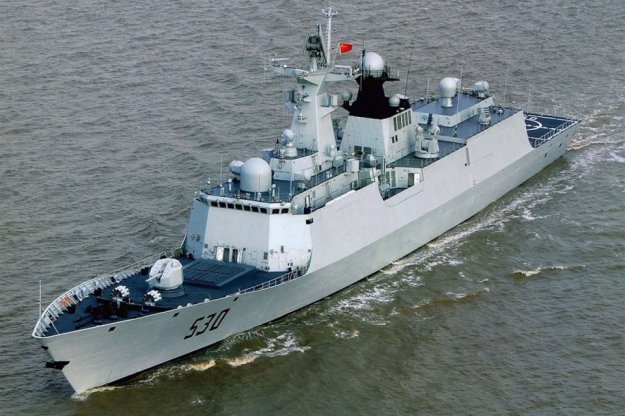 Type 054A Xuzhou (530) – Image: jeffhead.com
Type 054A Xuzhou (530) – Image: jeffhead.com
China offered the sale of three Type 054A frigates to Thailand in 2013, but lost to South Korea, which offered its modified Gwanggaeto the Great-class destroyers.
Export Potential
A slightly modified version of the Type 054A has been promoted by Dalian China Shipbuilding and Offshore International (CSOC) for export to Pakistan and Thailand, as well as potentially Bangladesh and Algeria. Pakistan became China’s first customer for the frigates: in 2005 China and Pakistan signed a contract for four Chinese-built Type 054A frigates that included some modifications specified by the Pakistani Navy. The new frigate model is called the “F-22P,” and one was recently commissioned in Karachi in April 2013. Apparently three of the four ships were built in China, and the fourth is being constructed in Pakistan after China transferred the technology needed to build the ship.
While the Chinese courted the Thai Navy heavily and reportedly came close to selling three frigates to Thailand, the story ended with Bangkok ultimately choosing South Korea’s Daewoo as a more reliable and cost-effective option for the frigate purchase (the Chinese price was $255 million per frigate). This decision was made despite rumored pressure placed on the Thai Navy by Thailand’s executive branch to purchase a frigate from China. According to Thai media, several naval officers voiced concerns about the capacity and quality of frigates from China being lower than other options. Another complaint was that the ship’s steel structure is not durable.
According to Chinese sources, the weapon systems and radar on the export edition of the Type 054A are not exactly the same as the 054A currently in service in the PLAN. The export edition has a standard displacement of 3,800t, full load displacement 4,200t, length 136m, and height 8.6m. It can navigate on the sea for 90 days and nights, navigation range 4,000nm at a speed of 18 knots. It needs an operating crew of 160 and is powered by 4 diesel engines. This model of the FFG has a maximum speed of 26 knots, which is supposed to be one of the weaknesses of 054A. Modern FFGs and DDGs normally have a navigation speed of 30 knots. Source chinasignpost.com
F-22P Zulfiquar-class frigate
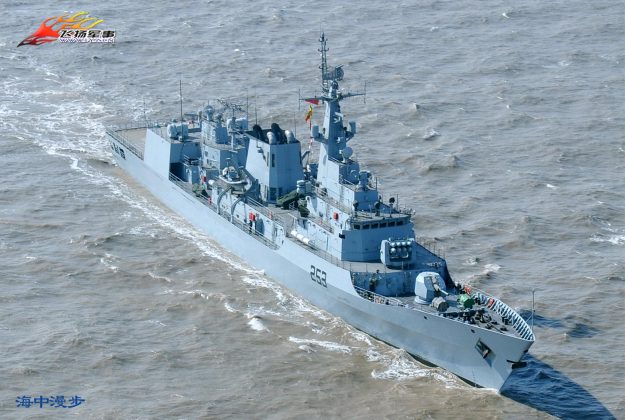 PNS Saif (253)
PNS Saif (253)
The F-22P or Zulfiquar-class frigate (Urdu: ذوالفقار English: Sword class), is a general purpose frigate built by Pakistan under license from China for the Pakistan Navy (PN). They are an adaptation of the Type 053H3 frigates of China but include elements of the Type 054 frigates as well.
The first ship, PNS Zulfiquar, was handed over to the PN on 30 July 2009 and the second, PNS Shamsheer, on 23 January 2010. The third frigate, PNS Saif was commissioned on 15 Sep 2011. The fourth and last frigate of F-22P series, PNS Aslat was inducted on 17 April 2013
| Name | Pennant | Laid down | Launched | Commissioning |
|---|---|---|---|---|
| PNS Zulfiquar | 251 | 12 October 2006 | 5 April 2008 | 19 September 2009 |
| PNS Shamsheer | 252 | 13 July 2007 | 31 October 2008 | 19 December 2009 |
| PNS Saif | 253 | 4 November 2008 | 28 May 2009 | 15 September 2010 |
| PNS Aslat | 254 | 10 Dec 2009 | 16 June 2011 | 17 April 2013 |
| Class overview | |
|---|---|
| Name: | Zulfiquar (Sword) class |
| Builders: | Karachi Shipyard & Engineering Works, Karachi |
| Operators: | |
| Preceded by: | Type 053H3 frigate |
| Cost: | USD$175 million |
| Planned: | 4 |
| Completed: | 4 |
| Active: | 4 |
| General characteristics | |
| Type: | Frigate |
| Displacement: |
|
| Length: | 123.2 m (404 ft) |
| Beam: | 13.8 m (45 ft) |
| Draught: | 3.76 m (12.3 ft) |
| Propulsion: |
|
| Speed: | 29 kn (54 km/h) maximum |
| Range: | 4,000 nmi (7,400 km) |
| Complement: | 170 crew |
| Sensors and processing systems: |
|
| Electronic warfare & decoys: |
|
| Armament: | |
| Aircraft carried: | 1 × Harbin Z-9EC ASW helicopter |
| Aviation facilities: | Flight deck and enclosed hangar |
| Notes: |
|
Source wikiwand.com
Royal Thai Navy’s DW-3000F Frigate: Here
Chinese Assessments of the Type 054A
Much of the open source coverage of the Type 054A as it has participated in the above missions has been positive, as are assessments by Chinese analysts as well as those who have commanded or otherwise sailed on the ships. Major problems from the Gulf of Aden deployments are not mentioned in Chinese publications or by foreign analysts, who almost certainly would have noted and reported on major problems such as engine failures or other mechanical issues that would require towing back to port and lengthy repair.
Some of the areas cited by Chinese defense analysts where the Type 054A design is vastly improved over the Type 054 include:
–Improved air defense: The Type 054A’s medium-range HQ-16 VLS SAM system now provides area air defense from all engagement angles up to a range of 50km, a considerable upgrade from the limited engagement angle, short range SAM system of the Type 054.
–Improved reaction time against close-in threats: The Type 054’s four AK-630 close-in weapon systems (CIWS) were replaced with two Type 730 CIWS on the Type 054A, which has far better reaction time for anti-aircraft and anti-missile engagements.
–More capable radar systems: A Russian-derived MR331 Mineral-ME fire-control radar (for anti-ship missile and for the main gun as its secondary mission), capable of over the horizon targeting, has been installed on the Type 054A frigate.
–Better stealth design: The V-shaped hull design combined with stealth radar capabilities makes the 054A a quieter and stealthier ship.
While coverage of areas for improvement of the Type 054A is sparse, a few sources did note that improvements to the next iteration of stealth frigates, the Type 054B, would be focused on the electronic equipment used in the combat information command system as well as changes to the weapons configuration. This could indicate that the Type 054B will be equipped with new air defense and anti-ship missiles.
Type 054B
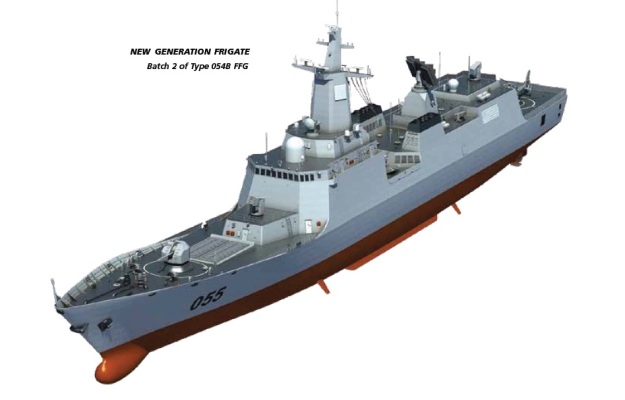
The upgraded capabilities of the Type 054A reflect its expanded mission sets and enhance the ability of the ship to defend itself against a range of threats that it might encounter in both the regional seas and missions abroad, to include potential conflicts with regional navies as well as pirates in distant waters. Given the Type 054A’s success to date and the strong likelihood that the PLAN will seek improved follow on variants, it is important to analyze the research, development, and procurement process that the PLAN used to bring the Type 054A into the fleet. Source chinasignpost.com
Type 054A design and features

The stealthy hull design of the Type 054A features sloped sides and reduced superstructure for minimising the radar cross section. Designed primarily for anti-air warfare, the frigates are also equipped to conduct anti-surface and anti-submarine warfare missions.
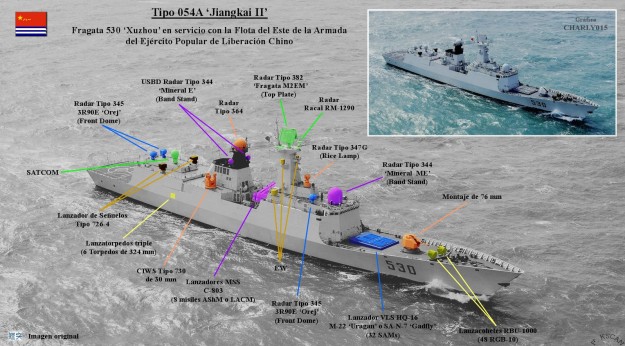
The Type 054A has a length of 134m and abeam of 16m. The standard displacement is 3,600t, while the full displacement is around 4,000t. Each vessel can complement a crew of 165.

–The lack of reporting to date in Chinese or foreign sources regarding engine failures or other major mechanical problems suggests that the Type 054A has recorded decent operational reliability in the six and a half years (and counting) that the People’s Liberation Army Navy (PLAN) has maintained its Gulf of Aden anti-piracy mission.
–While the Type 054A represents an exponential improvement in the quality and capability of the PLAN’s frigate force, it nonetheless remains a distinctly limited design, certainly in terms of its size and armament but most especially in terms of its electronics outfit. The Chinese appear to recognize this fact and view the 054A as an intermediary design intended to play a specific, limited role in fleet defense.
–Notwithstanding its physical shortcomings, the Type 054A has performed well handling lower intensity long-range mission In this regard, it has arguably surpassed the capabilities of the French Lafayette-class frigate that influenced its original design. Source chinasignpost.com

Type 054A missiles
The Type 054A is armed with HQ-16 medium-range surface-air missiles fired from 32-cell Vertical Launch System (VLS) developed by Luoyang Electro-Optics Technology Development Centre (EOTDC). The HQ-16 missile can engage aerial targets from all angles up to a range of 50km. The VLS is also expected to launch anti-submarine missile.
HQ-16 medium-range surface-air missile
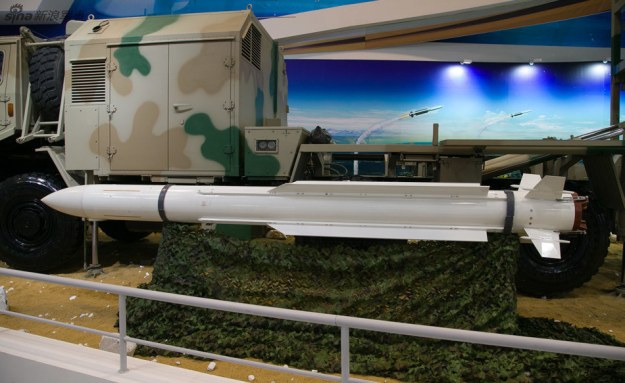
The HongQi-16 (HQ-16) is a third generation Chinese land-based mid-range surface-to-air missile defense system. It is similar to Russia’s SA-11 Gadfly or SA-17 Grizzly, and seems to be an evolved, Chinese version of those system. Not much else is known about this new system, but there are reports stating that it can intercept very low-flying targets at maximum distance of 40km. The HQ-16 is said to be more accurate than previous mid-range defense systems and fills in the performance gaps of the HQ-7 and HQ-9.
 HQ-16 Anti Air Missile – Image: chinesemilitaryreview.blogspot.com
HQ-16 Anti Air Missile – Image: chinesemilitaryreview.blogspot.com Type 054A Jiangkai-II class frigate of the People’s Liberation Army Navy (PLA Navy) test fires HQ-16 surface to air missile during an exercise.Type 054A frigate is equipped a 32-cell vertical launching system (VLS) which allows the HQ-16 to be launched at rapid rate. – Image: chinesemilitaryreview.blogspot.com
Type 054A Jiangkai-II class frigate of the People’s Liberation Army Navy (PLA Navy) test fires HQ-16 surface to air missile during an exercise.Type 054A frigate is equipped a 32-cell vertical launching system (VLS) which allows the HQ-16 to be launched at rapid rate. – Image: chinesemilitaryreview.blogspot.com Video capture of an HHQ-16 launch intercepting what appears to be a low altitude target drone – Image: plarealtalk.com
Video capture of an HHQ-16 launch intercepting what appears to be a low altitude target drone – Image: plarealtalk.com
Chinese news websites report that the HQ-16’s performance data is roughly:
- Effective range of 1.5-30 km
- Effective Altitude of 10-6000 meters
- Single hit probability of 0.7-0.98
- Reaction time 5-8 seconds
- 9 m long missile
- Projectile diameter 0.232 m
- Weighs 165 kg
- Warhead weight of 17 kg
- Maximum flight speed of Mach 2.8.
Data missilethreat.com
CY-5 (Chiang Ying, Long Tassel) ASROC-type missile
 A PLAN naval drill in July saw the likely first images of an ASROC-type torpedo-carrying missile, fired from the vertical launch system of a Type 054A ‘Jiangkai II’-class frigate. The official designator of this missile is uncertain, although some sources suggest nomenclature of CY-5 (Chiang Ying , Long Tassel). Source: Screengrab from CCTV @janes.com
A PLAN naval drill in July saw the likely first images of an ASROC-type torpedo-carrying missile, fired from the vertical launch system of a Type 054A ‘Jiangkai II’-class frigate. The official designator of this missile is uncertain, although some sources suggest nomenclature of CY-5 (Chiang Ying , Long Tassel). Source: Screengrab from CCTV @janes.com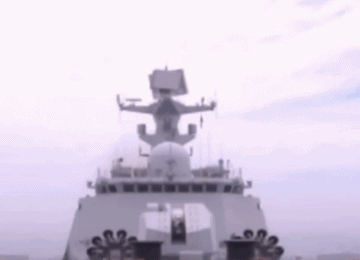 Image: plarealtalk.com
Image: plarealtalk.com
CY-5 is the vertically launched version of CY-4 with folding control surfaces to fit into VLS. The range is reported to be 30 km. The existence of CY-5 type weapon was first officially revealed in 2012 when Type 054A frigate was opened to public in Hong Kong, when the governmental explanation described the modular VLS at the bow of the ship can launch both air defense missiles and rocket propelled ASW torpedoes armed with various Chinese and western torpedoes. However, the exact designation of the rocket propelled ASW torpedo was not revealed. Because CY series was also first intended for export and armed with torpedoes of western origin, CY-5 is thus also most likely armed with Chinese Y-7, or other western light torpedoes such as A244-S. CY-5 is reportedly also deployed onboard Type 052D destroyer. Source wikipedia.org
Yu-8 anti-submarine missile launched from VLS of 054A Xiangtan
https://twitter.com/xinfengcao/status/880690922266271746
Yu-8 torpedo is a rocket propelled ASW torpedo similar to CY-5, but with a different payload. The exact type of the light weight torpedo (LWT) carried by Yu-8 has not been officially released by the Chinese governmental sources (as of 2016), but many military analysts and enthusiasts have concluded it is the Russian APR-3E torpedo based on other information released officially by the Chinese government in 2015, namely, the incorporation of data link on Yu-8:[8][9]
The Russian torpedo is approximately a meter, or a third longer than its western counterparts, such as A244-S, Sting Ray, or Mk 54, and is also nearly twice the weight of its western counterparts, but more importantly, the range of Russian APR-3E LWT is only a third of that its western counterparts. If a very fast nuclear submarine is targeted by Yu-8 near its maximum range, then from the time Yu-8 is launched to its point of entry, the target might have already opened up the gap and thus has successfully escaped by getting out of the range of APR-3E. Just as in the case of CY-3 development from CY-2, to ensure the point of entry of Yu-8 is within the 3 km range of APR-3E, a datalink is also incorporated to enable the weapon to receive target update from other platforms such as surface ships and aircraft.[8][9] This feature is not a must for western LWT torpedoes with a range that is approximately three times of that of Russian LWT, and hence when the Chinese official sources have revealed the existence of datalink on Yu-8, it suggests the LWT Yu-8 delivers is Russian APR-3E or similar Chinese copies. Many military analysts and enthusiasts have also postulated that since the Russian LWT is larger and heavier, to maintain the same range of CY-5 armed with lighter and shorter torpedoes of western origin, the rocket motor of Yu-8 would have to be either larger or more powerful.
The existence of Yu-8 designation was first revealed in March 2014,[10] and confirmed more than a year later by CCTV-7 in August 2015, when it aired a footage of Chinese naval war game that contained the launch of rocket propelled ASW torpedo from VLS of a Chinese warship, with designation Yu-8 torpedo assigned.[5] Yu-8 is designed by the 705th Research Institute in Kunming, with program begun in 2002 and completed in 2006. Source wikiwand.com
The primary Anti-Surface Warfare (ASuW) system of the Type 054A is the YJ-83 (C-803) sea-skimming anti-ship cruise missile. The missile is launched by two quadruple launchers mounted at the mid-ship position. The YJ-83 missile can carry a 165kg conventional warhead to an operational range of 250km.

YJ-83 (C-803) sea-skimming anti-ship cruise missile

The YJ-83 (YingJi-83 meaning Eagle Strike) was designed by the Third Academy of the China Aerospace Science and Industry Corporation “CASIC” (HiWING Mechanical & Electrical Technology Corporation). The programme begun in the mid nineties and procurement with the PLAN begun in the late nineties. YJ-83 is a subsonic missile with a reported range of 150 Km (in its surface-launched version). It is a sea skeaming capable missile fitted with an active radar seeker. Source navyrecognition.com
 Yuncheng(571) – Image: navalanalyses.blogspot.com
Yuncheng(571) – Image: navalanalyses.blogspot.com
The YJ-83 is a long-range anti-ship missile designed to meet the requirements of the PLA Navy (PLAN). The YJ-83 has a range of 150 to 200 kilometers and introduces a data-link to receive target updates from airborne assets such as helicopters or fixed-wing aircraft. The YJ-83 can fly at supersonic speeds (Mach 1.5) during the terminal phase of the flight (approx 15 kilometers). The PLAN is deploying the YJ-83 missile as the standard anti-ship missile onboard frigates and destroyers.
Dimensions
Diameter: 0.36 meter
Length: 6.39 meter (21.0 foot)
Wingspan: 1.22 meter
Performance
Max Range: 200 kilometer (108 nautical mile)
Speed
Cruise Speed: 0.90 mach (1,076 kph)
Top Speed: 1.50 mach (1,793 kph)
Weight
Warhead: 165 kilogram (364 pound)
Source deagel.com
 临沂/Linyi (547) YJ-83 (C-803) sea-skimming anti-ship cruise missile
临沂/Linyi (547) YJ-83 (C-803) sea-skimming anti-ship cruise missile
New “missile” ASW
![[IMG]](https://i0.wp.com/www.eastpendulum.com/wp-content/uploads/2016/11/2016-11-20-la-marine-chinoise-multiplie-les-moyens-anti-sous-marins-25.jpg) Image: sinodefenceforum.com
Image: sinodefenceforum.com Image: sinodefenceforum.com
Image: sinodefenceforum.com
Naval gun systems and ASW weapons
The main gun fitted on the bow deck is a single-barrel 76mm gun. The frigate is armed with two indigenous Type 730 seven-barrel 30mm close-in weapon systems (CIWS) for close-point defence against aerial threats. The CIWS can fire 4,600 to 5,800 rounds per minute for a maximum range of 3,000m.
1 × PJ26 76 mm dual purpose gun

The 713th Institute (also known as Zhengzhou Electrical Engineering Research Institute) of China Shipbuilding Industry Corporation (CSIC) of the People’s Republic of China has developed a Chinese variant of AK-176, with Mr. Chen Dingfeng (陈汀峰) as the general designer. Design begun in 2000 and was completed in 2003. The primary difference between this H/PJ-26 and AK-176 is that the Chinese variant adopts a stealthy turret design, and more composite material is used in the construction of the turret. In addition, ready rounds for the H/PJ-26 are doubled to 150 rounds from the original 75 of the AK-176. Source wikiwand.com
PJ26 single tube 76MM stealth gun
PJ26 single tube 76MM gun stealth based AK176 single tube 76.2 mm gun stealth modifications on the Russian ship. In early 2000 determined by the Zhengzhou Institute of Mechanical and Electrical Engineering (713) as chief engineer units, and thus responsible for the development, general contracting, Chen Ting Feng served as the chief architect and was completed in 2003.
Performance parameters (Russia AK176 type):
total weight: 11500kg (including the lower deck loader)
Range: 11.5 ~ 15.5km
Rate of fire: 60 to 120 rounds / min
reserve ammunition: 152 Hair
barrel tilt range: -15 to +85 degree
level cyclotron range: about 175 degrees
Source haijun360.com
Type 730 seven-barrel (PJ-12) 30mm close-in weapon systems (CIWS)
 Type 730 CIWS Yuncheng (571) – Image: navalanalyses.blogspot.com
Type 730 CIWS Yuncheng (571) – Image: navalanalyses.blogspot.com
The Type 730 is a Chinese-made close-in weapon system (CIWS) based on a seven-barrel 30mm gun with a maximum rate of fire of approximately 4,600 to 5,800 rounds per minute. This CIWS weapon system provides short-range air defense to the latest ships commissioned by the People’s Liberation Army Navy (PLAN). Source deagel.com
18th 054A onwards the seven barrel PJ-12 was replaced by the PJ-11 (H/PJ-14)
 Left: seven barrel PJ-12 30mm CIWS installed on 054A hulls 1-17, Right: eleven barrel PJ-11 30mm CIWS installed on 054A hulls 18 and onwards – Source plarealtalk.com
Left: seven barrel PJ-12 30mm CIWS installed on 054A hulls 1-17, Right: eleven barrel PJ-11 30mm CIWS installed on 054A hulls 18 and onwards – Source plarealtalk.com
A pair of PJ-12 (also known as Type 730) close in weapon systems (CIWS) provide a robust last ditch anti air, anti missile and anti surface capability. The PJ-12 is a 7 barrel, 30mm calibre gatling gun featuring its own fire control radar and electro-optic targeting system. PJ-12 is similar in arrangement to the Dutch Goalkeeper CIWS, but is reportedly actually influenced by the aborted French SAMOS CIWS. The seven barrel PJ-12 equips 054A hulls 1 to 17, from the 18th 054A onwards, the seven barrel PJ-12 was replaced by the more formidable PJ-11, an eleven barrel variant of the PJ-12 that had previously only been fitted aboard the aircraft carrier Liaoning. Source plarealtalk.com
| Properties: Capable vs Seaskimmer |
| Targets: Aircraft, Helicopter, Missile, Surface Vessel |
| Weapons: |
|---|
| 30mm China H/PJ-14 [Type 1130, 500 rnds] – (China, 11 Barrels, Upgr Goalkeeper Copy) Gun Air Max: 1.9 km. Surface Max: 2.8 km. |
Source cmano-db.com
The anti-submarine warfare (ASW) capabilities are provided by two Type 87 six-tube ASW rocket launchers and tow 324mm YU-7 ASW torpedo launchers. Each rocket has a 34kg warhead and can strike under-water targets within the range of 1,200m.
2 x Type 87 six-tube ASW rocket launcher
 Type 87 six-tube ASW rocket launcher Yuncheng (571) – Image: navalanalyses.blogspot.com
Type 87 six-tube ASW rocket launcher Yuncheng (571) – Image: navalanalyses.blogspot.com
There are two Type 87 six-tube anti-submarine rocket launchers installed on the bow deck, with 36 rockets (240mm calibre, 34kg warhead). The maximum range is 1,200m. Source defensetiger.blogspot.com
| Targets: Submarine |
| Weapons: |
|---|
| China Type 87 ASW Rocket Salvo [6 rnds] – Rocket Subsurface Max: 3.7 km. |
Source cmano-db.com
2 324mm YU-7 ASW torpedo launchers
 Type-054A Frigate Anti-submarine Exercises – Image: errymath.blogspot.com
Type-054A Frigate Anti-submarine Exercises – Image: errymath.blogspot.com
YU-7 ASW torpedo

The Yu-7 is a lightweight torpedo of Chinese origin. Since 1984 China tried to copy and later produce under license the US Mk 46 torpedo. This proved to be difficult and a batch of Italian A.224S torpedoes was ordered and the two designs were mated. An electrically powered Yu-7 offspring called the ET-52 was developed and put into service before the development of the Yu-7 was finished.
 Type-054A Frigate Anti-submarine Exercises – Image: errymath.blogspot.com
Type-054A Frigate Anti-submarine Exercises – Image: errymath.blogspot.com
The Yu-7 is a mixture of the Mk 46 Mod 1 and Mod 2 with various components from the A.224S torpedo. The Yu-7 retains the complex Otto fuel engine which provides it with a better performance than the electrically powered ET-52. The layout is conventional with the seeker in the nose, the warhead in the middle and the fuel and engine at the rear.
The Yu-7 uses a combination of passive and active acoustic guidance. It is believed that the Mk 46 seeker design is retained but several components have been replaced by those from the A.224S.
| Type | Anti-submarine torpedo |
| Platform | Aircraft, surface ships |
| Diameter | 324 mm |
| Length | 2.6 m |
| Weight | 235 kg |
| Warhead | 45 kg |
| Guidance | Active/passive acoustic seeker |
| Propulsion | Twin propeller |
| Power supply | Otto Fuel II |
| Speed | 43 kt |
| Range | 10 km |
| Depth | 6 to 400 m depth |
Source weaponsystems.net
Variable depth sonar from hull 18 onwards
The 054A class also fields a comprehensive undersea sensor suite for ASW roles. All 054As are equipped with a bow sonar and a towed array sonar as well as a towed torpedo decoy system, and from all ships from hull 18 onwards have also been equipped with an additional variable depth sonar, appearing to be the same type mounted on the 056A class corvette. Such a comprehensive sonar suite, combined with a hangar and helipad for a helicopter, makes the 054A a very viable and competent ASW surface combatant within the Chinese Navy’s order of battle. Source plarealtalk.com
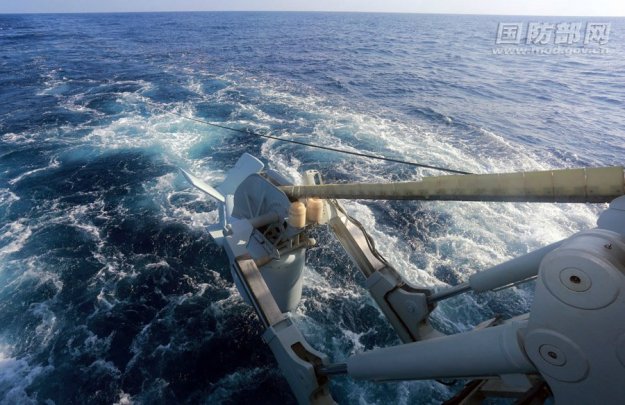
| General data: | |
|---|---|
| Type: VDS, Active/Passive Sonar | Altitude Max: 0 m |
| Range Max: 14.8 km | Altitude Min: 0 m |
| Range Min: 0 km | Generation: Early 1970s |
| Sensors / EW: |
|---|
| China SJD-X [Unknown VDS] – (Type 054++, Type 056 ASW) VDS, Active/Passive Sonar Role: VDS, Active/Passive Variable Depth Sonar Max Range: 14.8 km |
Source cmano-db.com
Type 054A Towed Torpedo Decoy
Photography of a Type 054A frigate with a streamed tow cable has recently been seen on Chinese websites. The accompanying discussions on the blog sites state this is evidence of a towed array. Source admiraltytrilogy.com

Flight deck
 Kamov Ka-28 Helix on Type-054A Frigate Anti-submarine Exercises – Image: errymath.blogspot.com
Kamov Ka-28 Helix on Type-054A Frigate Anti-submarine Exercises – Image: errymath.blogspot.com
The stern helicopter deck features a single landing spot for supporting the missions of a medium size helicopter. The heli-deck is fitted with helicopter handling system and can accommodate a Kamov Ka-28 Helix or a Harbin Z-9C helicopter.
Kamov Ka-28 Helix
 Kamov Ka-28 Helix on Type-054A Frigate Anti-submarine Exercises – Image: errymath.blogspot.com
Kamov Ka-28 Helix on Type-054A Frigate Anti-submarine Exercises – Image: errymath.blogspot.com
| Kamov Ka-27PL ‘Helix-A’ | |
| Entered service | 1982 |
| Crew | 3 men |
| Dimensions and weight | |
| Length | 11.27 m |
| Main rotor diameter | 15.9 m |
| Height | 5.45 m |
| Weight (empty) | 6.1 t |
| Weight (maximum take off) | 12.6 t |
| Engines and performance | |
| Engines | 2 x Klimov TV3-117V turboshaft engines |
| Engine power | 2 x 2 190 hp |
| Maximum speed | 250 km/h |
| Cruising speed | 230 km/h |
| Service ceiling | 5 km |
| Range | 800 km |
| Payload | |
| Maximum payload | 5 t |
| Typical load | ? |
| Armament | |
| Torpedoes | 4 x APR-2E homing torpedoes |
| Bombs | 4 x groups of S3V guided anti-submarine bombs in place of torpedoes |
 Image: combataircraft.com
Image: combataircraft.com
Data military-today.com
Harbin Z-9C helicopter
 Chinese Type 054A Jiangkai II class FFG-546 Yancheng Guided Missile Frigate on patrol in Mediterranean Sea. Image: Chinese Military Review
Chinese Type 054A Jiangkai II class FFG-546 Yancheng Guided Missile Frigate on patrol in Mediterranean Sea. Image: Chinese Military Review
Z-9C: Version for PLA Naval Air Force, for deployment aboard certain classes of destroyers and frigates; in service by late 2000. Believed to be equivalent to Arriel 2-engined Eurocopter AS 565 Panther, but equipped with Thales HS-12 dipping sonar and KLC-11/J-band (Chinese version of Agrion 15) surface search radar; armament includes two Yu-7 torpedoes or TV-guided C-701 anti-surface vessel missiles. Source aviastar.org
Specifications (Z-9B)
Data from
General characteristics
- Crew: 1 or 2 pilots
- Capacity: 10 passengers or 1,900 kg (4,189 lb) payload internal, 1,600 kg (3,527 lb) payload slung
- Length: 12.11 m (39 ft 9 in)
- Height: 4.01 m (13 ft 2 in)
- Empty weight: 2,050 kg (4,519 lb)
- Max takeoff weight: 4,100 kg (9,039 lb)
- Powerplant: 2 × Zhuzhou Aeroengine Factory WZ-8A turboshaft, 632 kW (848 hp) each
- Main rotor diameter: 11.94 m (39 ft 2 in)
- Main rotor area: 111.98 m2 (1,205.3 sq ft) swept area
Performance
- Maximum speed: 305 km/h (190 mph; 165 kn)
- Cruising speed: 260 km/h (162 mph; 140 kn)
- Ferry range: 1,000 km (621 mi; 540 nmi) with internal auxiliary tank
- Endurance: 5 hours
- Service ceiling: 4,500 m (14,764 ft) * Hovering Ceiling in ground effect: 2,600 m (8,530 ft)
- Hovering Ceiling out of ground effect: 1,600 m (5,249 ft)
Armament
2 fixed 23 mm Type 23-2 (AM-23) cannon on attack variants. Pylons for rockets, gun pods, ET52 torpedo, HJ-8 anti-tank missiles, or TY-90 air-to-air missiles.

Technical data wikiwand.com
Sensors and radars aboard the Type 054A frigate

The Type 054Afrigate is equipped with Type 382 3D air/surface search radar, MR-36A surface search radar, and two Racal RM-1290 navigation radars operating in I-band. The 3D search radar can simultaneously track up to 40 targets within the maximum range of 120km.
 Image: errymath.blogspot.com
Image: errymath.blogspot.com
Type 382 3D air/surface search radar
 Yuncheng (571) Type 382 3D air/surface search radar – Image: navalanalyses.blogspot.com
Yuncheng (571) Type 382 3D air/surface search radar – Image: navalanalyses.blogspot.com
Type 382 radar is a Chinese naval 3-D air search radar designed to replace earlier Chinese Type 381.
Contrary to many frequent but erroneous claim, Type 382 radar is not a simple Chinese copy of Russian MR-710 Fregat (meaning frigatebird) radar (NATO reporting name: Top Plate), though Type 382 does borrow heavily from MR-710 radar. Type 382 radar program had already begun in the early 1990s, before the start of the negotiation of importing Russian Sovremennyy-class destroyer in 1994. Type 382 is designed to be a successor of earlier Type 381, but development had run into technological bottleneck for the next generation passive phased array radar due to the technical and industrial limitations in the early and mid-1990s China had at the time. The import of Russian MR-710 radar had provided a significant boost in the development of Type 382 radar in that designers of Type 382 can borrow ideas of MR-710, and as a result, Type 382 has become a cross between Type 381 and MR-710. L Source wikiwand.com
 Image: errymath.blogspot.com
Image: errymath.blogspot.com
The Type 344 (Mineral-ME Band Stand) radar above the bridge provides ship-ship missile control, over-the-horizon radar acquisition and target designation of surface vessels, while four Type 345 (NATO reporting name: MR-90 Front Dome) F-band radars provide two channels to guide two air defence missiles simultaneously.
 A photo of 054A’s darkened CIC during typical operations – Source plarealtalk.com
A photo of 054A’s darkened CIC during typical operations – Source plarealtalk.com
Type 344 (Mineral-ME Band Stand) radar
Mineral system (‘Band Stand’) is used for missile guidance, MR331 Mineral ME ( Russian export version Monolit or Band Stand in Western code) is a team able to locate targets beyond the radar horizon. Which is essential guide surface-to-surface missiles.


Type 345 (NATO reporting name: MR-90 Front Dome)

 Yuncheng (571) Type 345 (NATO reporting name: MR-90 Front Dome) at bottom of pic – Image: navalanalyses.blogspot.com
Yuncheng (571) Type 345 (NATO reporting name: MR-90 Front Dome) at bottom of pic – Image: navalanalyses.blogspot.com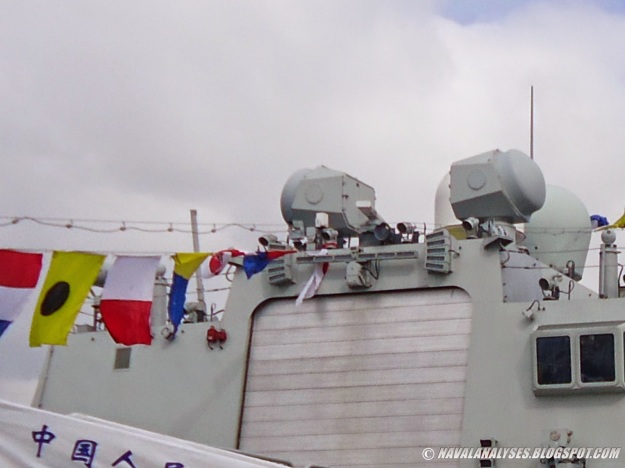 Yuncheng (571) Type 345 (NATO reporting name: MR-90 Front Dome) on top of hanger – Image: navalanalyses.blogspot.com
Yuncheng (571) Type 345 (NATO reporting name: MR-90 Front Dome) on top of hanger – Image: navalanalyses.blogspot.com
| General data: | |
|---|---|
| Type: Radar | Altitude Max: 30480 m |
| Range Max: 74.1 km | Altitude Min: 0 m |
| Range Min: 0.4 km | Generation: Early 1980s |
| Properties: Pulse Doppler Radar (Full LDSD Capability), Continuous Wave Illumination |
| Sensors / EW: |
|---|
| Front Dome [MR-90 Orekh] – (1981, Fire Dome?) Radar Role: Radar, FCR, Surface-to-Air, Short-Range Max Range: 74.1 km |
The ship is also fitted with TR47C and Type 347G fire-control radars for the CIWS and 76mm main gun. The frigate is also equipped with MGK-335 medium frequency active/passive sonar system integrating Bull Horn active and Whale Tongue passive hull-mounted, search and attack sonar.
TR47C/Type 347G fire-control radar

The Type 347G “Rice Bowl” I-band fire-control radar is found on Chinese Navy ships, in conjection with the Type 76A dual-37mm automatic AAA gun. Typically, the system includes 2 Type 347G fire-control radar with optical director, and 4 Type 76A guns. They’re used on the Luda, Luhu, Luhai, Jiangwei class surface warships, as well as the Houjian, Houxin, and Haiging class patrol boats.
Type 347 radar is frequently but erroneously referred by many as either Type 349 or Type 348, because externally, all three radars look very similar, and all three are developed as fire control radar for small caliber guns. In reality, the three radars are different and they can be easily distinguished by the following features: When electro-optics (EO) are integrated with radar, EO is installed on the portside of Type 347 radar antenna, but for Type 348 and Type 349, EO is installed on the starboard side of the radar antenna. Furthermore, when incorporated as part of CIWS, Type 349 is slaved to Type 730 CIWS gun and thus does not rotate, because the gun rotates when searching/tracking. In contrast, Type 348 is not slaved to the Type 76 37mm twin guns, but instead, installed separately from the gun mounts, and thus Type 348 rotates when searching/tracking. The shape of antenna is also an important visual cue to distinguish three radars. The tip of Type 349 radar is a conical, which is missing on Type 347. Instead, the tip of Type 347 radar antenna is a small circular flat surface, missing the tip of the cone. The antenna of Type 348 radar differs from both Type 347 and Type 349 radars in that most of the cone is missing, only the base remains, so the antenna of Type 348 radar has a very large circular flat surface, resulting in Type 348 radar resembles a scaled down version of another larger fire control radar for larger caliber guns (76 mm or greater), Type 344.
Specifications
- X-band
(Specs based on RTN-20X)
- Beam: 2.2 deg
- Gain: 37 dBi
- Range:
- Target acquisition for 2m2: 12 km (verified for LR66)
- Target acquisition for 0.1m2: 6 km (verified for LR66)
- Other features:
- Uses a coherent pulse doppler design
- Non coherent Moving Target Indicator/Detection (MTI, MTD), CFAR (Constant False Alarm Rate)
- Antinodding, anti clutter capability (A well advertised feature of the RTN family)
- Other reported names:
- TR47C
Source wikiwand.com
Bull Nose (MGK-335M Platina) Hull Sonar

| General data: | |
|---|---|
| Type: Hull Sonar, Active/Passive | Altitude Max: 0 m |
| Range Max: 27.8 km | Altitude Min: 0 m |
| Range Min: 0 km | Generation: Early 1980s |
| Sensors / EW: |
|---|
| Bull Nose [MGK-335M Platina] – (1981, Assoc w Mare Tail & Steer Hide) Hull Sonar, Active/Passive Role: Hull Sonar, Active/Passive Search Max Range: 27.8 km |
Source cmano-db.com
Countermeasures
 Yuncheng (571) – Image: navalanalyses.blogspot.com
Yuncheng (571) – Image: navalanalyses.blogspot.com
The countermeasures are provided by two 18-tube multiple rocket launchers capable of firing decoys/chaffs. Other electronic warfare systems include Type 922-1 radar warning receiver and HZ-100 Electronic Counter Measures (ECM) and Electronic Support Measures (ESM) system.
Type 922-1 radar warning receiver
 People’s Liberation Army (Navy) ships consisted of a Type 903 Replenishment Ship, the Taihu, and two Type 054A Guided Missile Frigates the Yancheng and the Daqing on visit to VICTORIA, Canada – Image: jgmjgm516.blogspot.com
People’s Liberation Army (Navy) ships consisted of a Type 903 Replenishment Ship, the Taihu, and two Type 054A Guided Missile Frigates the Yancheng and the Daqing on visit to VICTORIA, Canada – Image: jgmjgm516.blogspot.com
2 × Type 726-4 18-tube decoy rocket launchers
 Yuncheng (571) Type 726-4 18-tube decoy rocket launcher (From pic it is 24 tube) – Image: navalanalyses.blogspot.com
Yuncheng (571) Type 726-4 18-tube decoy rocket launcher (From pic it is 24 tube) – Image: navalanalyses.blogspot.com
Propulsion
The combined diesel and diesel (CODAD) propulsion system integrates four SEMT Pielstick (now MAN Diesel) 16 PA6V-280 STC diesel engines produced locally under license at Shaanxi Diesel Factory. Each engine, with a sustained power of 4,720kW (6,330hp), provides a total power output of 18,880kW (25,320hp). The propulsion system provides a maximum speed of 27kt and range of more than 8,000nmi.
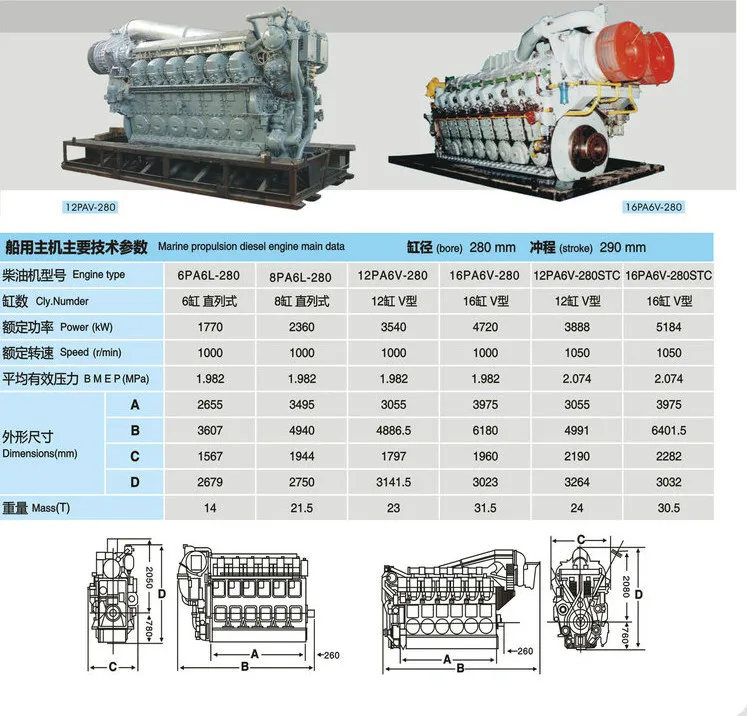
Main material source naval-technology.com
Costs of Building a Type 054A
We estimate that the Type 054A currently costs a total of approximately US$348 million per vessel to build and fit out. This estimate derives from breaking the ship down by its main systems categories (hull and equipment, propulsion/power transmission, weapons, and electronics) and calculating their respective costs, as well as the cost of the labor needed to assemble the ship into a finished product. We rely heavily on valuation by analogy in many cases because Chinese sources simply do not disclose cost information on the vast majority of the inputs being used in warships being built in China. As such, the figure as stands is conservative and may overestimate the construction and equipment costs.
Type 054A Cost Breakdown
Million USD, Percentage of total estimated ship cost (numbers rounded)
 Source: Alibaba, U.S. Navy, Local and Foreign Media Sources, Authors’ Analysis
Source: Alibaba, U.S. Navy, Local and Foreign Media Sources, Authors’ Analysis
The next section elaborates sequentially on the Type 054A’s cost structure, with the areas that contribute the most to final ship cost addressed first.
Electronics: US$102 million, 29%. Chinese military-grade electronics makers disclose little or no information on the unit costs of systems then produce for the PLA. Furthermore, the PLA does not publish detailed budgets such as those commonplace in the U.S. Department of Defense (DoD). As such, this analysis uses a valuation by analogy approach to estimate the likely cost of the ship’s main electronics systems. The ship’s ZKJ-4B/6 combat data system is said to be based on Thompson CSF’s Tavitac. The Naval Institute Guide to World Naval Weapons Systems, 1997-1998 estimated that the Tavitac accounted for less than 5% of the final cost of the French Lafayette-class frigate, which based on the US$466 million original unit cost of the six Lafayette-class frigates (“Kang Ding”) purchased by Taiwan in 1992, suggests Tavitac costs approximately US$20 million. Given the systems’ stated similarity, it is reasonable to value the ZKJ-4B/6 at US$20 million per unit.
The Type 382 3D search radar likely costs approximately US$15 million per unit based on the price of the AMD radar system Saab sold to Australia for its Canberra-class LHD and the fact that Chinese radar makers likely have not yet attained the experience and efficiency level of Saab’s production process. The Type 054A’s sonar suite likely costs around US$20 million, based on the unit cost of the Royal Navy’s Sonar 2087 and the procurement requirements the U.S. Navy used in 2005 when specifying the characteristics of a new towed sonar array. Finally, the authors estimate that the Type 054A’s machinery control system costs US$15 million, based on the fact that Northrup Grumman has contracted to supply the much larger LHA-7 amphibious assault ship’s machinery control system at a cost of US$50.6 million. We acknowledge that shipboard electronics costs may in fact be lower, although no data presently known to us supports a lower cost.
 Yuncheng (571) – Image: navalanalyses.blogspot.com
Yuncheng (571) – Image: navalanalyses.blogspot.com
Weapons: US$84 million, 24%. The most expensive part of the Type 054A’s weapons suite is likely the vertical launching system cells. An 8-cell module from the US Mk 41 VLS system—the most widely used in the world—costs around US$15 million. The Type 054A has 32 total VLS cells and the author discounts the 8-cell module cost to US$10 million, making the system cost an estimated US$40 million. The second most expensive component of the Type 054A’s armament are its two Type 730 close in weapon systems (“CIWS”), which likely cost around US$11 million for both. The U.S. Navy’s Phalanx Block 1B CIWS costs US$5.6 million per unit, and we believe this is a reasonable proxy for the Type 730 CIWS cost because although the Chinese gun is a larger caliber and the system is physically larger, the assembly and materials costs are likely substantially lower.
 Yuncheng (571) – Image: navalanalyses.blogspot.com
Yuncheng (571) – Image: navalanalyses.blogspot.com
Labor: US$75 million, 22%. While data are somewhat scarce, building and commissioning a frigate-sized warship of between 3,000 and 4,000 tons displacement appears to require between 2.5 million man hours (US FFG-7) and 10.8 million man hours (India’s Godavari-class) of labor. We estimate that at present, Chinese military shipyards, which can afford a higher degree of labor intensity than Western yards due to a large labor force, but which are also almost certainly substantially more efficient than Indian yards, require around 3.2 million man hours to build and commission a Type 054A frigate. Chinese yards’ average labor cost is based on the 2013 labor expenditures of Jiangsu Rongsheng, a top private shipbuilder, which are then increased by 25% to reflect the premium paid for special skill sets required for shipbuilding work done to naval specifications.
Hull and equipment: US$45 million, 13%. This cost estimate is based on the fact that around one-third of the light ship weight of surface combatants such as the Type 054A typically consists of metals—primarily steel, along with lesser quantities of high-grade alloys and wiring and pipes. The author then multiplied the 1,200 tonnes of steel likely required for a ship the size of the Type 054A by an average cost of US$2,000/tonne for high quality steel such as that used in warships. The remainder of the cost comes from composite materials and radar absorbent materials, whose cost data were obtained from similar items sold on Alibaba.com and from the cost of applying radar absorbent coatings to frigate-sized U.S. warships, as disclosed by the Chicago Tribune (admittedly a bit dated as it is 1993-vintage). Cost data for paint, piping, pumps, valves, and wiring also come from similar Chinese-made items advertised for sale on Alibaba.com as well as the London Metals Exchange spot price for copper, the underlying component of wiring and likely at least part of the pipe alloys.
Propulsion: US$32 million, 9%. The biggest share of the Type 054A’s propulsion costs come from its four Pielstick/Shaanxi PA6 diesel engines. At least one trading company offers Pielstick engines for sale at between US$1and US$10 million apiece. This estimate uses the mid-range price of $5 million per engine to reflect the size of the engine and the premium quality needed for a military application. The balance of the estimated cost reflects the gearbox, drive shafts, steering gear, and props.

Miscellaneous costs: US$10 million, 3%. This category is a “catchall” that helps the overall estimate account for bits and pieces that might have been overlooked in the process of estimating each ship segment’s cost. Source chinasignpost.com
Class overview |
|
|---|---|
| Builders: |
|
| Operators: | People’s Liberation Army Navy Surface Force |
| Preceded by: | Type 054 frigate |
| Subclasses: |
|
| Cost: | ¥ 1.58 billion |
| Building: | 5 as of May 2015 |
| Active: | 22 |
| General characteristics | |
| Type: | Frigate |
| Displacement: | 4,053 tonnes (full)(CCTV report) |
| Length: | 134.1 m (440 ft)(CCTV report) |
| Beam: | 16 m (52 ft) (CCTV report) |
| Propulsion: | CODAD, 4 x Shaanxi 16 PA6 STC diesels, 5700 kW (7600+ hp @ 1084 rpm) each |
| Speed: | 27 kn estimated |
| Range: | 8025 nautical miles estimated |
| Complement: | 165 |
| Sensors and processing systems: |
|
| Electronic warfare & decoys: |
|
| Armament: |
|
| Aircraft carried: | 1 Kamov Ka-28 ‘Helix’ or Harbin Z-9C |
| Aviation facilities: | hangar |

Export
Thailand
In Feb 2013, China offered to sell Thailand 3 customized 054A frigates (“054T”) for 30 billion Thai baht ($1 billion USD) total. However, in April 2013 it was reported that South Korea had won the Royal Thai navy’s frigate bid with 1 modified Gwanggaeto the Great-class destroyers at 13 billion Thai baht each.
Russia
In Early 2015, it was reported that Russia might consider buying 054A for its navy.
Malaysia
According to a news report at LIMA 2015, the Royal Malaysian Navy will buy the C28A corvette export variant of the Chinese multi-role warship.
Updated Jan 12, 2018




Great work,I am a blogger from Pakistan!
LikeLike
Brilliant coverage as always…always learn much from your work…thank you!
LikeLike
Thanks
LikeLike